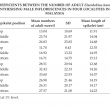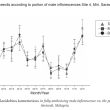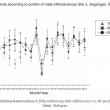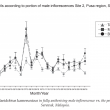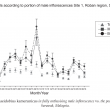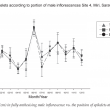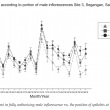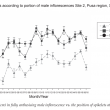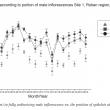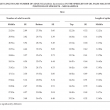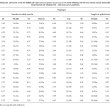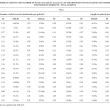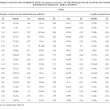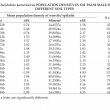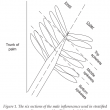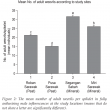Journal of Oil Palm Research Vol. 33 (1) March 2021, p. 21-36
POPULATION DENSITY OF Elaeidobius kamerunicus Faust IN DIFFERENT SPIKELET POSITION AT ANTHESISING MALE INFLORESCENCE OF Elaeis guineensis Jacq. IN SABAH AND SARAWAK, MALAYSIA
DOI: https://doi.org/10.21894/jopr.2020.0075
Received: 14 February 2020 Accepted: 12 June 2020 Published Online: 8 October 2020
The oil palm male inflorescences provide food source and breeding sites for the pollinating weevil, Elaeidobius kamerunicus (E. kamerunicus). The present study examined the difference in the formation of the oil palm male inflorescences on different soil types, and how the differences affect the population density of E. kamerunicus. Samplings of adult E. kamerunicus and the spikelets of fully-anthesising oil palm male inflorescences were conducted monthly for a period of 18 months at four oil palm plantations on peat and mineral soils in East Malaysia. E. kamerunicus population density in peat soil areas was found to be lower than those in mineral soils (P<0.05). It was also found that the male inflorescences spikelet length in the study sites on peat soil areas were less uniform; spikelets on the upper part of the inflorescence were significantly shorter (= 12.80 cm) compared to the spikelets sampled from the bottom part of the inflorescence (= 14.91 cm, P< 0.05, P= 0.000-0.031). In addition, compared to the lower part of the inflorescence, significantly fewer weevils were found lodged on the spikelets sampled from the upper part of the inflorescence (Site 1Top = 8 adult weevils spikelet-1; Site 2Top = 12 adult weevils spikelet-1; Site 1bottom = 18 adult weevils spikelet-1; Site 2bottom= 17 adult weevils spikelet-1). However, no significant correlation was found between the length of the spikelet and the weevil density on each spikelet (r= 0.021-0.181). The result from this study demonstrates the influence of the soil types on the formation of the inflorescence, which requires further investigation.
KEYWORDS:FIGURES & TABLES:
* Malaysian Palm Oil Board,
6 Persiaran Institusi,
Bandar Baru Bangi,
43000 Kajang,
Selangor, Malaysia.
E-mail: saharul.abillah@mpob.gov.my
** Universiti Putra Malaysia,
Faculty of Agriculture and Food Sciences,
Institute in Ecosystem Science Borneo,
Jalan Nyabau,
Peti Surat 396,
97008 Bintulu,
Sarawak, Malaysia.
